Over the past couple of years, the changing consumer and business environments have impacted retail as much—or more—than any other industry. The pandemic severely affected the retail industry's ability to connect physically with customers. As retail pivots to selling consumer goods and services through multiple channels, it must overcome challenges to enable cloud services, scale online presences, maintain real-time stock control, and manage valuable assets using retail data.
For the past few years, Red Hat's Portfolio Architecture team has been developing reference architectures based on customers' real-world use cases in various industries. We have multiple criteria for developing and vetting an architecture collection before publishing it, which you can read in my intro article about Portfolio Architectures.
We're publishing these architectures for anyone's use on our Red Hat Portfolio Architecture Center and our community site, the Portfolio Architecture Examples repository.
This article presents seven architectures for the retail industry. Retail is the process of selling consumer goods or services to customers through multiple distribution channels to earn a profit. Retailers satisfy customer demand identified through a supply chain.
The term retailer is typically applied when a service provider fills small orders from many individuals (who are end users) rather than large orders from a small number of wholesale, corporate, or government clients.
Following are the seven architectures in the retail collection. I'll provide a short overview of each and allow you to explore them in depth on your own.
- Business optimization: Optimizing delivery routing, automating rostering of staff, and improving the efficiency of tasks across multiple stores
- Headless e-commerce: Deploying a container-based e-commerce website while moving away from tightly coupled existing e-commerce platforms
- Point of sale: Simplifying and modernizing central management of distributed point-of-sale devices with built-in support for container-based applications
- Real-time stock control: Providing near-real-time stock positions and dynamic pricing promotions to retail omnichannels
- Retail data framework: Creating a framework for access to retail data from customers, stock, and staff across multiple internal teams
- Store health and safety: Managing effective in-store compliance, health and safety, and employee checks and procedures
- Supply chain integration: Streamlining integration between different elements of a retail supply chain for on-premises, cloud, and other third-party interactions
In the Red Hat Portfolio Architecture Center, you'll find a table of contents outlining the technologies used in each architecture, several example schematic diagrams with descriptions, and a link to open the diagrams directly into the online tooling in your browser.
Business optimization architecture
Business optimization helps retailers manage the supply chain's complexity to provide goods and services when and where they are needed.
[ Learn how to Modernize your IT with managed cloud services. ]
The business optimization architecture aids retailers by optimizing delivery routing, automating staff scheduling, and improving the efficiency of tasks across multiple stores.

Headless e-commerce architecture
E-commerce (electronic commerce) allows companies and individuals to buy and sell goods and services over the internet. The headless e-commerce architecture helps retailers deploy a container-based e-commerce website while moving away from tightly coupled existing e-commerce platforms.
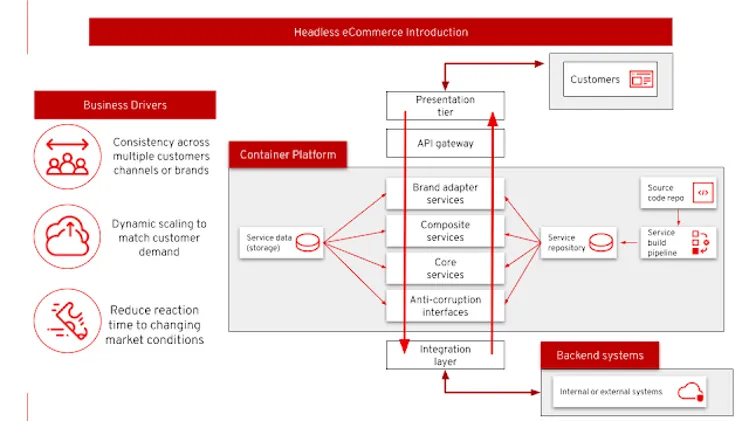
Point-of-sale architecture
A point of sale (or point of purchase) is the location where you charge customers. When customers check out online, walk up to your counter, or pick out an item from your stand or booth, they're at the point of sale. A point-of-sale system is the hardware and software that enables a business to make those sales.
[ Plan your next cloud project based on your current cloud results by asking these 4 essential cloud project questions. ]
The point-of-sale architecture simplifies and modernizes central management of distributed point-of-sale devices with built-in support for container-based applications.
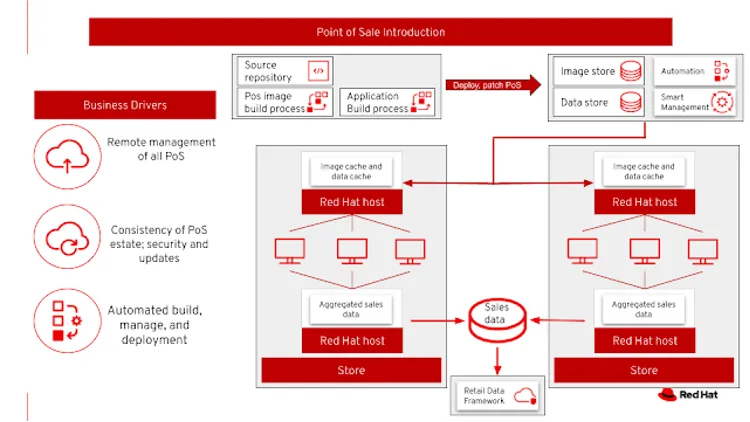
Real-time stock control architecture
Real-time stock control (also known as inventory management) is an automated process that uses software to record sales and purchases. It gives a complete picture of what's happening with inventory, allowing businesses to react quickly to supply chain needs.
The real-time stock control architecture provides near-real-time stock positions and dynamic pricing promotions information to omnichannel retailers.

Retail data framework architecture
A retail data framework handles managing enterprise retail data. The framework or system sets the guidelines and rules of engagement for business and management activities, especially those dealing with or resulting in data creation and manipulation.
The retail data framework architecture creates a framework for access to retail data about customers, stock, stores, and staff across multiple internal teams.
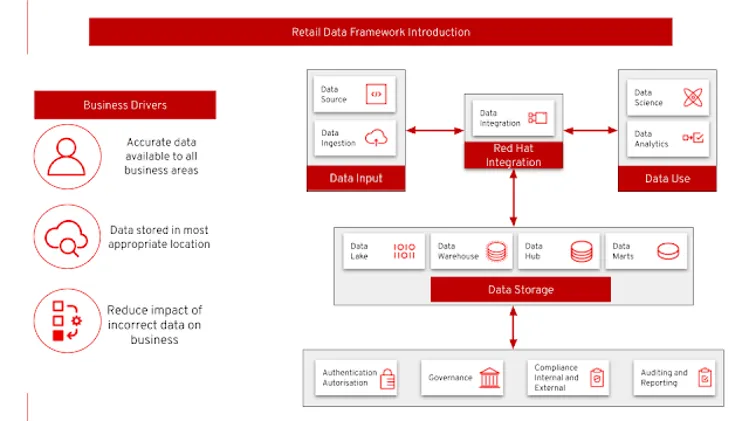
Store health and safety architecture
Store health and safety are all about managing risks to protect workers and stores. In a global context, health and safety are also an essential part of the movement toward sustainable operational growth.
[ Find out what Red Hat can do for your organization by exploring the Red Hat product trial center. ]
The store health and safety architecture helps retailers manage in-store compliance, health, and safety. It also handles employee checks and procedures effectively.
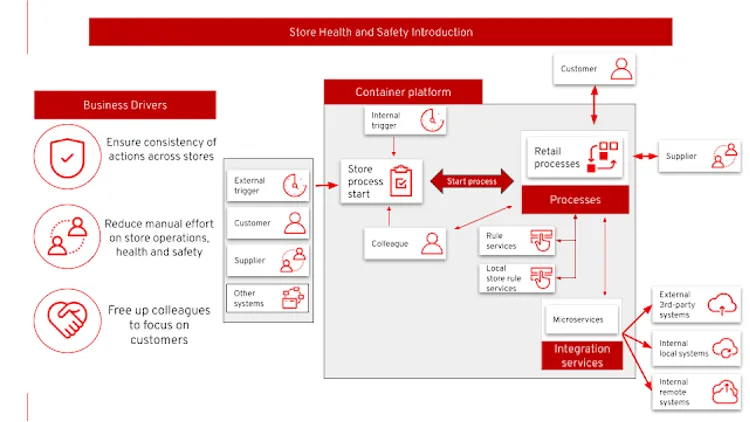
Supply chain integration architecture
Supply chain integration is a large-scale business strategy that aims to bring the chain's links into a closer working relationship with each other. The goal is to improve response and production time and reduce costs and waste.
The supply chain integration architecture's use case is to streamline integration between different retail supply chain elements for on-premises, cloud, and other third-party interactions.
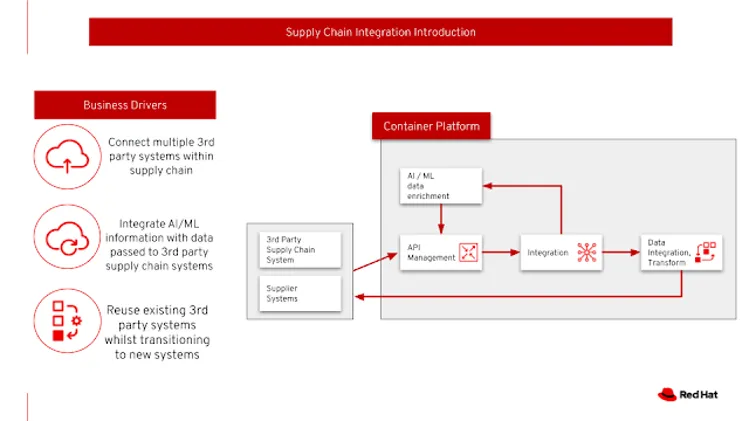
Learn more
These are seven of the many reference architectures Red Hat's Portfolio Architects have published, and we'll continue to publish them as we complete them. If you are interested in more architecture solutions like these, feel free to explore the Red Hat Portfolio Architecture Center.
This article originally appeared on Eric D. Schabell's blog and is republished with permission.
À propos de l'auteur
Parcourir par canal
Automatisation
Les dernières nouveautés en matière d'automatisation informatique pour les technologies, les équipes et les environnements
Intelligence artificielle
Actualité sur les plateformes qui permettent aux clients d'exécuter des charges de travail d'IA sur tout type d'environnement
Cloud hybride ouvert
Découvrez comment créer un avenir flexible grâce au cloud hybride
Sécurité
Les dernières actualités sur la façon dont nous réduisons les risques dans tous les environnements et technologies
Edge computing
Actualité sur les plateformes qui simplifient les opérations en périphérie
Infrastructure
Les dernières nouveautés sur la plateforme Linux d'entreprise leader au monde
Applications
À l’intérieur de nos solutions aux défis d’application les plus difficiles
Programmes originaux
Histoires passionnantes de créateurs et de leaders de technologies d'entreprise
Produits
- Red Hat Enterprise Linux
- Red Hat OpenShift
- Red Hat Ansible Automation Platform
- Services cloud
- Voir tous les produits
Outils
- Formation et certification
- Mon compte
- Assistance client
- Ressources développeurs
- Rechercher un partenaire
- Red Hat Ecosystem Catalog
- Calculateur de valeur Red Hat
- Documentation
Essayer, acheter et vendre
Communication
- Contacter le service commercial
- Contactez notre service clientèle
- Contacter le service de formation
- Réseaux sociaux
À propos de Red Hat
Premier éditeur mondial de solutions Open Source pour les entreprises, nous fournissons des technologies Linux, cloud, de conteneurs et Kubernetes. Nous proposons des solutions stables qui aident les entreprises à jongler avec les divers environnements et plateformes, du cœur du datacenter à la périphérie du réseau.
Sélectionner une langue
Red Hat legal and privacy links
- À propos de Red Hat
- Carrières
- Événements
- Bureaux
- Contacter Red Hat
- Lire le blog Red Hat
- Diversité, équité et inclusion
- Cool Stuff Store
- Red Hat Summit

